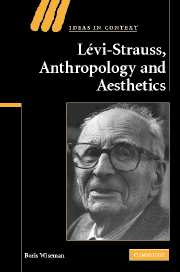Book contents
- Frontmatter
- Contents
- List of illustrations
- Acknowledgements
- Introduction: ethno-aesthetics
- 1 The reconciliation
- 2 Art and the logic of sensible qualities
- 3 The work of art as a system of signs
- 4 Structuralism, Symbolist poetics and abstract art
- 5 The anthropologist as art critic
- 6 Nature, culture, chance
- 7 From myth to music
- 8 Lévi-Strauss's mytho-poem
- Conclusion: between concept and metaphor
- References
- Index
- IDEAS IN CONTEXT
Conclusion: between concept and metaphor
Published online by Cambridge University Press: 27 October 2009
- Frontmatter
- Contents
- List of illustrations
- Acknowledgements
- Introduction: ethno-aesthetics
- 1 The reconciliation
- 2 Art and the logic of sensible qualities
- 3 The work of art as a system of signs
- 4 Structuralism, Symbolist poetics and abstract art
- 5 The anthropologist as art critic
- 6 Nature, culture, chance
- 7 From myth to music
- 8 Lévi-Strauss's mytho-poem
- Conclusion: between concept and metaphor
- References
- Index
- IDEAS IN CONTEXT
Summary
The starting point of this book was a question about the interrelation of the anthropological and aesthetic strands of Lévi-Strauss's thought. The intuition that I have tried to verify is that Lévi-Strauss's aesthetic thought is not something added to his anthropology, but an integral part of it. Anthropological and aesthetic questions intertwine, and do so at the most elementary levels of elaboration of his thought. As I have shown, this is the case with his understanding of concrete logic, the nature/culture dichotomy, myth-making and the very concept of ‘structure’. I have further tried to show that this way of relating anthropology and aesthetics is a fertile avenue of inquiry. It brings to light the inherent value of interdisciplinarity. In bringing together otherwise unconnected bodies of knowledge, theoretical discourses, as well as cultures and traditions, one creates new totalities that are greater than the sum of their parts.
Throughout this book, I have proceeded by interrelating Lévi-Strauss's many writings, by setting them in broader literary and philosophical contexts and by examining their development, all the time showing that, in the structural imaginary, aesthetics and anthropology are inseparable. From the start, this study of a series of interdisciplinary connections gave rise to another kind of question, that of the nature of the texts written by Lévi-Strauss. The analysis of theory led to something else, what I have called the (mytho)poetic content of Lévi-Strauss's works.
- Type
- Chapter
- Information
- Levi-Strauss, Anthropology, and Aesthetics , pp. 217 - 229Publisher: Cambridge University PressPrint publication year: 2007



